Blog
Runners and Blisters

People who enjoy running are often familiar with blisters. Patients who get them often can generally feel when they are developing blisters and may wear running socks to prevent them. Blisters come from wearing shoes and socks that can cause excess friction and develop as the body’s natural defense to heal damaged skin. It is defined as a small area that resembles a bubble that is filled with fluid, and it immediately forms over the damaged skin. When new skin has formed, the blister will gradually drain as it is no longer needed. There may be existing medical reasons why people get blisters including eczema and psoriasis, in addition to having overly dry skin. A bunion may be the cause of blisters forming on the feet and this often happens from wearing shoes that are too tight. It is beneficial for people who run to gradually build up the skin on their feet as this may lead to getting blisters less often. If you frequently get blisters on your feet and would like to know more information about treatment and prevention, please confer with a podiatrist.
Blisters may appear as a single bubble or in a cluster. They can cause a lot of pain and may be filled with pus, blood, or watery serum. If your feet are hurting, contact one of our podiatrists of New York Foot and Ankle. Our doctors can provide the care you need to keep you pain-free and on your feet.
Foot Blisters
Foot blisters are often the result of friction. This happens due to the constant rubbing from shoes, which can lead to pain.
What Are Foot Blisters?
A foot blister is a small fluid-filled pocket that forms on the upper-most layer of the skin. Blisters are filled with clear fluid and can lead to blood drainage or pus if the area becomes infected.
Symptoms
(Blister symptoms may vary depending on what is causing them)
- Bubble of skin filled with fluid
- Redness
- Moderate to severe pain
- Itching
Prevention & Treatment
In order to prevent blisters, you should be sure to wear comfortable shoes with socks that cushion your feet and absorb sweat. Breaking a blister open may increase your chances of developing an infection. However, if your blister breaks, you should wash the area with soap and water immediately and then apply a bandage to the affected area. If your blisters cause severe pain it is important that you call your podiatrist right away.
If you have any questions, please feel free to contact one of our offices located in Franklin Square, Bethpage, Bronx, Brooklyn, and Massapequa, NY . We offer the newest diagnostic and treatment technologies for all your foot care needs.
Hard and Soft Corns
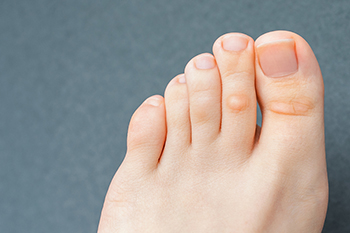
A small area of hardened skin on the pinky toe, top of the toes, or on the sole of the foot can be a corn. It develops as a result of excess friction that can happen from wearing shoes that are too tight. Additionally, corns can develop from standing or walking for long periods as a result of the weight and constant pressure from the body. There are noticeable signs of corns, like sensitive skin surrounding the corn, and it may be difficult to wear shoes. Hard corns are the most common and often form in wider areas of thickened skin, and soft corns develop between the toes and remain moist. Some corns may feel better when the foot is soaked in warm water, followed by gently rubbing it with a pumice stone. If the corn is a bit larger, it can be difficult to remove and will often need medical attention. Many people will wear a protective pad over the corn as this can provide protection and temporary relief until medical attention is sought. It is beneficial to wear shoes that fit properly and this may be an effective method in preventing corns. Corns are treated by a podiatrist and it is advised that you schedule an appointment with this type of doctor to correctly remove your corn.
If you have any concerns regarding your feet and ankles, contact one of our podiatrists of New York Foot and Ankle. Our doctors will treat your foot and ankle needs.
Corns: What Are They? and How Do You Get Rid of Them?
Corns can be described as areas of the skin that have thickened to the point of becoming painful or irritating. They are often layers and layers of the skin that have become dry and rough, and are normally smaller than calluses.
Ways to Prevent Corns
There are many ways to get rid of painful corns such as wearing:
- Well-fitting socks
- Comfortable shoes that are not tight around your foot
- Shoes that offer support
Treating Corns
Treatment of corns involves removing the dead skin that has built up in the specific area of the foot. Consult with Our doctors to determine the best treatment option for your case of corns.
If you have any questions please feel free to contact one of our offices located in Franklin Square, Bethpage, Bronx, Brooklyn, and Massapequa, NY . We offer the newest diagnostic and treatment technologies for all your foot and ankle needs.
Pain in the Pinky Toe
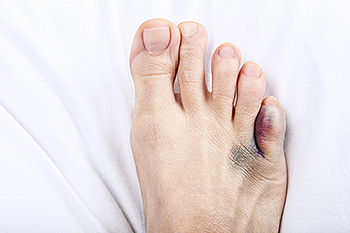
Pain in the fifth toe, commonly referred to as the pinky toe, can be quite problematic. Although the pinky is the smallest of all the toes on the feet, pinky toe pain can be uncomfortable nonetheless. Since this toe is located on the outside of the foot, the pinky toe can be especially prone to stubbing and injuries. If you are experiencing pain in the pinky toe, there could be any number of causes. First, you might have broken or fractured the pinky toe. Broken toes will sometimes release a popping sound when impacted. X-rays might be needed to analyze the toe and its fracture. Another potential cause of pinky toe pain is ill-fitting footwear that makes the pinky toe rub up against the shoe. Lastly, pinky toe pain can be caused by the development of a corn. Similar to a thick, hardened callus, corns on the pinky toe can be painful when they are rubbed against the inside of a pair of shoes. Pain in the pinky toe is no joke — it is suggested you see a podiatrist who can help you address the problem.
Toe pain can disrupt your daily activities. If you have any concerns, contact one of our podiatrists of New York Foot and Ankle. Our doctors can provide the care you need to keep you pain-free and on your feet.
What Causes Toe Pain?
Most severe toe pain is caused due to a sports injury, trauma from dropping something heavy on the toe, or bumping into something rigid. Other problems can develop over time for various reasons.
Toe pain can be caused by one or more ailments. The most common include:
- Trauma
- Sports injury
- Wearing shoes that are too tight
- Arthritis
- Gout
- Corns and calluses
- Hammertoe
- Bunions
- Blisters
- Ingrown toenails
- Sprains
- Fractures (broken bones)
- Dislocations
When to See a Podiatrist
- Severe pain
- Persistent pain that lasts more than a week
- Signs of infection
- Continued swelling
- Pain that prevents walking
Diagnosis
In many cases the cause of toe pain is obvious, but in others, a podiatrist may want to use more advanced methods to determine the problem. These can range from simple visual inspections and sensation tests to X-rays and MRI scans. Prior medical history, family medical history, and any recent physical traumatic events will all be taken into consideration for a proper diagnosis.
Treatment
Treatments for toe pain and injuries vary and may include shoe inserts, padding, taping, medicines, injections, and in some cases, surgery. If you believe that you have broken a toe, please see a podiatrist as soon as possible.
If you have any questions please feel free to contact one of our offices located in Franklin Square, Bethpage, Bronx, Brooklyn, and Massapequa, NY . We offer the newest diagnostic tools and technology to treat your foot and ankle needs.
Why Live with Pain and Numbness in Your Feet?
An Achilles Tendon Injury May Be More Common Among Men
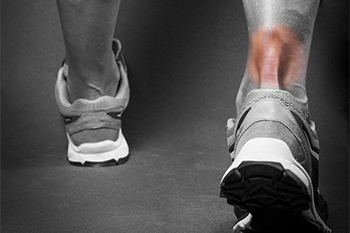
The medical term for the part of the foot that is known as the Achilles tendon is referred to as the calcaneal tendon. It is located in the back of the calf, and connects the heel to the calf muscles. It is considered to be the largest tendon in the body, and is responsible for pointing and flexing the foot. A foot mishap may result in an Achilles tendon injury, and this often causes severe pain and discomfort. This tendon could partially tear, and in the worse case scenario, may completely rupture. It can happen to people who enjoy the sport of running, and increasing the mileage and speed too soon may result in this type of injury. It is common among men who choose to participate in certain sporting activities during time off from work, and their bodies may not be used to twisting and turning, and the Achilles tendon may become injured. The symptoms that are generally associated with this condition include swelling, the inability to stand, and there may be a popping noise at the time of the injury. For a ruptured Achilles tendon, surgery may be necessary to repair the foot so daily activities can resume. If you have injured your Achilles tendon, please consult with a podiatrist who can guide you toward the best treatment options for you.
Achilles tendon injuries need immediate attention to avoid future complications. If you have any concerns, contact one of our podiatrists of New York Foot and Ankle. Our doctors can provide the care you need to keep you pain-free and on your feet.
What Is the Achilles Tendon?
The Achilles tendon is a tendon that connects the lower leg muscles and calf to the heel of the foot. It is the strongest tendon in the human body and is essential for making movement possible. Because this tendon is such an integral part of the body, any injuries to it can create immense difficulties and should immediately be presented to a doctor.
What Are the Symptoms of an Achilles Tendon Injury?
There are various types of injuries that can affect the Achilles tendon. The two most common injuries are Achilles tendinitis and ruptures of the tendon.
Achilles Tendinitis Symptoms
- Inflammation
- Dull to severe pain
- Increased blood flow to the tendon
- Thickening of the tendon
Rupture Symptoms
- Extreme pain and swelling in the foot
- Total immobility
Treatment and Prevention
Achilles tendon injuries are diagnosed by a thorough physical evaluation, which can include an MRI. Treatment involves rest, physical therapy, and in some cases, surgery. However, various preventative measures can be taken to avoid these injuries, such as:
- Thorough stretching of the tendon before and after exercise
- Strengthening exercises like calf raises, squats, leg curls, leg extensions, leg raises, lunges, and leg presses
If you have any questions please feel free to contact one of our offices located in Franklin Square, Bethpage, Bronx, Brooklyn, and Massapequa, NY . We offer the newest diagnostic tools and technology to treat your foot and ankle needs.
Is My Toe Broken or Bruised?
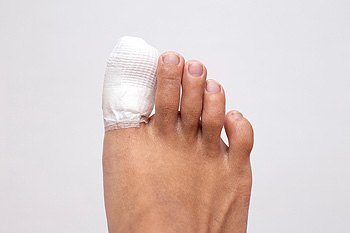
The most common method of differentiating between a broken toe and a bruised toe is to have an X-ray taken. They both can cause severe pain and discomfort. A severely broken toe can look deformed, and the bone can protrude from the toe at an abnormal angle. The symptoms that are associated with both of these types of injuries can include swelling, bruising, and difficulty walking. The buddy taping system for a bruised toe can cause the affected toe to feel better, as a result of the stability it provides. This is done by taping the toe to the toe next to it, and having it remain that way for several days. The buddy taping method works well for broken toes, as it causes the injured toe to remain still as the healing process occurs. In both scenarios, it is suggested to refrain from putting weight on the foot, which gives the broken or bruised toe ample time to heal. If you think you have broken or bruised your toe, it is advised to have it checked by a podiatrist who can guide you toward the proper treatment.
A broken toe can be very painful and lead to complications if not properly fixed. If you have any concerns about your feet, contact one of our podiatrists from New York Foot and Ankle. Our doctors will treat your foot and ankle needs.
What to Know About a Broken Toe
Although most people try to avoid foot trauma such as banging, stubbing, or dropping heavy objects on their feet, the unfortunate fact is that it is a common occurrence. Given the fact that toes are positioned in front of the feet, they typically sustain the brunt of such trauma. When trauma occurs to a toe, the result can be a painful break (fracture).
Symptoms of a Broken Toe
- Throbbing pain
- Swelling
- Bruising on the skin and toenail
- The inability to move the toe
- Toe appears crooked or disfigured
- Tingling or numbness in the toe
Generally, it is best to stay off of the injured toe with the affected foot elevated.
Severe toe fractures may be treated with a splint, cast, and in some cases, minor surgery. Due to its position and the pressure it endures with daily activity, future complications can occur if the big toe is not properly treated.
If you have any questions please feel free to contact one of our offices located in Franklin Square, Bethpage, Bronx, Brooklyn, and Massapequa, NY . We offer the newest diagnostic and treatment technologies for all your foot and ankle needs.
Toenail Fungus Is Contagious, and May Be Prevented
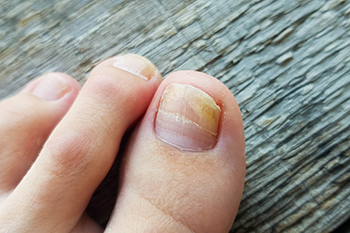
Toenail fungus can be an unpleasant and unsightly foot condition, despite the fact it is generally not serious. The majority of people may experience this type of fungus at some point in their lives, and it can be difficult to treat. It occurs as a result of the fungus entering the body through tiny cracks in the skin on the feet. This type of fungus is known to be contagious, and it lives and thrives in warm and moist environments, including shower room floors and locker rooms. It is advised to wear appropriate shoes while in these types of areas, as this can help to stop the spread of toenail fungus. The noticeable symptoms consist of a thickening and yellowing of the toenails, often starting with the big toe. This infection can cause the toenails to become brittle, and they may be difficult to trim correctly. In severe cases, the surrounding skin can become red and irritated, and may begin to itch. Many patients have found effective preventive methods for this type of fungus. These consist of wearing shoes that are made of natural materials, and refraining from sharing towels, shoes, and socks. Additionally, shoes that have been contaminated with this fungus need to be replaced, and keeping the toenails trimmed may aid in helping to prevent toenail fungus. If you are afflicted with this infection, it is suggested that you confer with a podiatrist at the beginning stages who can offer you correct treatment techniques.
For more information about treatment, contact one of our podiatrists of New York Foot and Ankle. Our doctors can provide the care you need to keep you pain-free and on your feet.
Toenail Fungus Treatment
Toenail fungus is a condition that affects many people and can be especially hard to get rid of. Fortunately, there are several methods to go about treating and avoiding it.
Antifungals & Deterrence
Oral antifungal medicine has been shown to be effective in many cases. It is important to consult with a podiatrist to determine the proper regiment for you, or potentially explore other options.
Applying foot powder on the feet and shoes helps keep the feet free of moisture and sweat.
Sandals or open toed shoes – Wearing these will allow air movement and help keep feet dry. They also expose your feet to light, which fungus cannot tolerate. Socks with moisture wicking material also help as well.
If you have any questions please feel free to contact one of our offices located in Franklin Square, Bethpage, Bronx, Brooklyn, and Massapequa, NY . We offer the newest diagnostic tools and technology to treat your foot and ankle needs.
The Connection Between Hammertoes and Improper Footwear
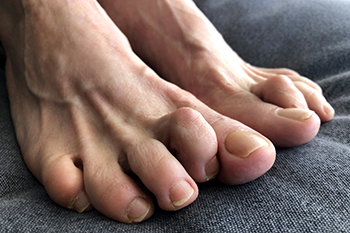
Wearing shoes that fit your feet and are comfortable can avoid many problems. Hammertoes are one such problem that can develop from wearing shoes that have pointy toes, are too tight, or that otherwise put pressure on your toes. The second and third toes are the most likely toes to be affected. Hammertoes get their name because the middle joint of the toe gets stuck in an upward bent position, creating a deformity resembling a hammer. This deformity is the result of an imbalance in the muscles and ligaments around the toe joint caused by either improper footwear or other factors such as genetics, overly high arches, bunions, injuries, and certain medical conditions. Shoes with uppers that are soft and flexible, as well as those that provide arch support and ample room in the toe box, can help prevent hammertoes. It is important to treat hammertoes early, before they become rigid. A podiatrist can treat your hammertoe and may also help you select footwear that will help prevent hammertoes from occurring in the future.
Hammertoe
Hammertoes can be a painful condition to live with. For more information, contact one of our podiatrists from New York Foot and Ankle. Our doctors will answer any of your foot- and ankle-related questions.
Hammertoe is a foot deformity that affects the joints of the second, third, fourth, or fifth toes of your feet. It is a painful foot condition in which these toes curl and arch up, which can often lead to pain when wearing footwear.
Symptoms
- Pain in the affected toes
- Development of corns or calluses due to friction
- Inflammation
- Redness
- Contracture of the toes
Causes
Genetics – People who are genetically predisposed to hammertoe are often more susceptible
Arthritis – Because arthritis affects the joints in your toes, further deformities stemming from arthritis can occur
Trauma – Direct trauma to the toes could potentially lead to hammertoe
Ill-fitting shoes – Undue pressure on the front of the toes from ill-fitting shoes can potentially lead to the development of hammertoe
Treatment
Orthotics – Custom made inserts can be used to help relieve pressure placed on the toes and therefore relieve some of the pain associated with it
Medications – Oral medications such as anti-inflammatories or NSAIDs could be used to treat the pain and inflammation hammertoes causes. Injections of corticosteroids are also sometimes used
Surgery – In more severe cases where the hammertoes have become more rigid, foot surgery is a potential option
If you have any questions please contact one of our offices located in Franklin Square, Bethpage, Bronx, Brooklyn, and Massapequa, NY . We offer the newest diagnostic and treatment technologies for all your foot and ankle needs.
Two Methods of Measuring Feet
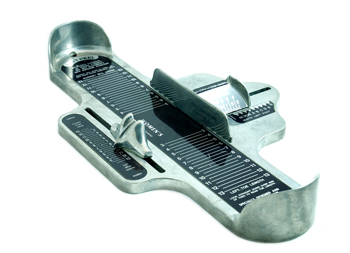
The importance of knowing your correct shoe size before making a purchase is crucial for the health of your feet. The majority of shoe stores have an object known as the Brannock device, which can accurately measure your shoe size. Additionally, if you choose to measure your feet at home there is a simple procedure that can accomplish this. It is important to wear the socks that would normally be worn with the shoes, followed by taping a piece of paper to the floor directly under a wall. After stepping on the paper, trace the outline of your foot. The next step is to measure the length of the foot and this will tell you your shoe size. It is suggested to try on both shoes at the end of the day when the feet are at their largest. A comfortable fit is crucial from the beginning and research has shown that shoes should not have to be broken in. There are also different types of footwear for various sports. If you would like more information about what type of shoes to buy, please confer with a podiatrist who can answer any questions you may have.
Getting the right shoe size is an important part of proper foot health. Seek the assistance of one of our podiatrists from New York Foot and Ankle. Our doctors will provide the care you need to keep you pain-free and on your feet.
Getting the Right Shoe Size
There are many people who wear shoes that are the incorrect size, negatively affecting their feet and posture. Selecting the right shoes is not a difficult process, so long as you keep several things in mind when it comes to choosing the right pair.
- When visiting the shoe store, use the tools available to measure your foot.
- Be sure there is ‘wiggle room’. There should be about an inch between your toes and the tip of your shoes.
- Do not always assume you are the same size, as manufacturers run differently.
- Purchase shoes later in the day, as your feet swell as the day progresses.
- If a shoe is not comfortable, it is not suitable. Most shoes can’t be ‘broken in’, and comfort should be the ultimate goal when it comes to choosing the right pair of shoes
As our feet hold our body weight and keep us moving, it is important to treat them right. Picking the right pair of shoes can provide your feet comfort and mobility without pain.
If you have any questions, please feel free to contact one of our offices located in Franklin Square, Bethpage, Bronx, Brooklyn, and Massapequa, NY . We offer the newest diagnostic and treatment technologies for all your foot care needs.
Do Your Child's Feet Hurt?
More...
What Can Cause Plantar Fasciitis?
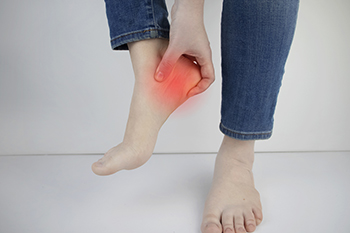
Plantar fasciitis develops as a result of an inflamed plantar fascia, which is the band of tissue that connects the heels to the toes and runs along the bottom of the foot. The fascia can become irritated for several reasons. These include obesity, standing on hard surfaces for long periods of time, and wearing shoes that do not fit correctly. Research has indicated that cases of plantar fasciitis have increased during the pandemic. This may be a result of more people walking or running outside on uneven surfaces when the gym was closed. Additionally, it is a possibility that flip-flops were worn most of the day while working remotely. These types of shoes have little or no arch support, which may be a contributing factor in developing plantar fasciitis. This condition can produce uncomfortable heel pain, and mild relief may be found by stretching the plantar fascia and Achilles tendon. Many patients have found it helps to wear shoes that offer good support. If you have this ailment, it is suggested that you are under the care of a podiatrist who can guide you toward the correct treatment.
Plantar fasciitis can be very painful and inconvenient. If you are experiencing heel pain or symptoms of plantar fasciitis, contact one of our podiatrists from New York Foot and Ankle. Our doctors can provide the care you need to keep you pain-free and on your feet.
What Is Plantar Fasciitis?
Plantar fasciitis is the inflammation of the thick band of tissue that runs along the bottom of your foot, known as the plantar fascia, and causes mild to severe heel pain.
What Causes Plantar Fasciitis?
- Excessive running
- Non-supportive shoes
- Overpronation
- Repeated stretching and tearing of the plantar fascia
How Can It Be Treated?
- Conservative measures – anti-inflammatories, ice packs, stretching exercises, physical therapy, orthotic devices
- Shockwave therapy – sound waves are sent to the affected area to facilitate healing and are usually used for chronic cases of plantar fasciitis
- Surgery – usually only used as a last resort when all else fails. The plantar fascia can be surgically detached from the heel
While very treatable, plantar fasciitis is definitely not something that should be ignored. Especially in severe cases, speaking to your doctor right away is highly recommended to avoid complications and severe heel pain. Your podiatrist can work with you to provide the appropriate treatment options tailored to your condition.
If you have any questions please feel free to contact one of our offices located in Franklin Square, Bethpage, Bronx, Brooklyn, and Massapequa, NY . We offer the newest diagnostic and treatment technologies for all your foot and ankle needs.
Volleyball Foot and Ankle Injuries

There is a risk of foot and ankle injury to those who play volleyball because of the repetitive jumping and side-to-side movements required in the sport. Foot injuries can also occur from overuse and under-resting when participating in volleyball. Ankle sprains, tendon injuries, and fractures are the most common injuries sustained from playing volleyball. Foot injuries can recur if not treated in a timely manner and properly healed. Taking proper care of sports injuries is sometimes a conundrum for athletes as they are eager to get back to doing what they love and may not take the necessary time to heal correctly. Chronic foot pain or ankle instability can develop and affect an athlete for a lifetime from improper care. If you or your child plays volleyball, consider seeing a podiatrist who can guide you in proper footwear, form, and exercises to prevent injury or treat an injury incurred.
Ankle and foot injuries are common among athletes and in many sports. They can be caused by several problems and may be potentially serious. If you are feeling pain or think you were injured in a sporting event or when exercising, consult with one of our podiatrists from New York Foot and Ankle. Our doctors will assess your condition and provide you with quality foot and ankle treatment.
Common Injuries
The most common injuries that occur in sporting activities include:
- Achilles Tendonitis
- Achilles Tendon Rupture
- Ankle Sprains
- Broken Foot
- Plantar Fasciitis
- Stress Fractures
- Turf Toe
Symptoms
Symptoms vary depending upon the injury and in some cases, there may be no symptoms at all. However, in most cases, some form of symptom is experienced. Pain, aching, burning, bruising, tenderness, tightness or stiffness, sensation loss, difficulty moving, and swelling are the most common symptoms.
Treatment
Just as symptoms vary depending upon the injury, so do treatment options. A common treatment method is known as the RICE method. This method involves rest, applying ice, compression and elevating the afflicted foot or ankle. If the injury appears to be more serious, surgery might be required, such as arthroscopic or reconstructive surgery. Lastly, rehabilitation or therapy might be needed to gain full functionality in the afflicted area. Any discomfort experienced by an athlete must be evaluated by a licensed, reputable medical professional.
If you have any questions, please feel free to contact one of our offices located in Franklin Square, Bethpage, Bronx, Brooklyn, and Massapequa, NY . We offer the newest diagnostic and treatment technologies for all your foot care needs.
Exercise May Help to Prevent Falling
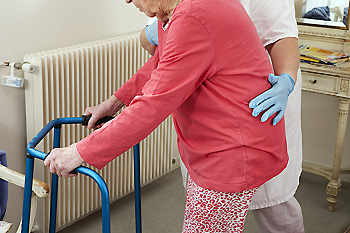
Research has indicated that practicing exercise is the most beneficial method that may help to decrease the risk of falling. This may be the most effective fall prevention method seniors 65 or older can practice. Other successful techniques can include improving lighting in the household, removing worn rugs, and installing grab bars in the shower and toilet area. Clutter is important to throw away, and this can help to make the home safer. Additionally, many seniors choose to use walkers and canes to maintain balance, and this can help to prevent falling. One out of five seniors will suffer a serious injury as a result of falling, and it is important to implement as many prevention strategies as possible. Having regular physical and eye examinations is necessary to keep medications and eyeglass prescriptions up to date. If you would like more information about how falling can affect the feet, and how to keep the home safe, please confer with a podiatrist.
Preventing falls among the elderly is very important. If you are older and have fallen or fear that you are prone to falling, consult with one of our podiatrists from New York Foot and Ankle. Our doctors will assess your condition and provide you with quality advice and care.
Every 11 seconds, an elderly American is being treated in an emergency room for a fall related injury. Falls are the leading cause of head and hip injuries for those 65 and older. Due to decreases in strength, balance, senses, and lack of awareness, elderly persons are very susceptible to falling. Thankfully, there are a number of things older persons can do to prevent falls.
How to Prevent Falls
Some effective methods that older persons can do to prevent falls include:
- Enrolling in strength and balance exercise program to increase balance and strength
- Periodically having your sight and hearing checked
- Discuss any medications you have with a doctor to see if it increases the risk of falling
- Clearing the house of falling hazards and installing devices like grab bars and railings
- Utilizing a walker or cane
- Wearing shoes that provide good support and cushioning
- Talking to family members about falling and increasing awareness
Falling can be a traumatic and embarrassing experience for elderly persons; this can make them less willing to leave the house, and less willing to talk to someone about their fears of falling. Doing such things, however, will increase the likelihood of tripping or losing one’s balance. Knowing the causes of falling and how to prevent them is the best way to mitigate the risk of serious injury.
If you have any questions, please feel free to contact one of our offices located in Franklin Square, Bethpage, Bronx, Brooklyn, and Massapequa, NY . We offer the newest diagnostic and treatment technologies for all your foot care needs.
Preventative Foot Care for Diabetics
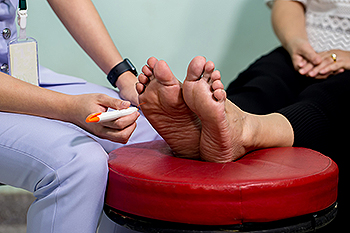
Anyone with diabetes is vulnerable to foot problems as a result of high blood sugar levels, which can damage the nerves in the legs and feet. The resulting numbness makes it more difficult to detect sores or cuts and to notice if shoes are too tight. It becomes harder to feel pain, temperature, and pressure, putting your feet in danger of infection. To avoid serious complications, such as foot ulcers, gangrene, or even amputation, a daily foot care plan is imperative for diabetics. First, check your feet daily for cuts, sores, or changes in color. Next, wash and carefully dry your feet before applying moisturizing cream to ward off dry or cracked skin. Avoid putting lotion between the toes. Protecting your feet is also essential. Wear shoes that fit properly, and avoid walking barefoot. Stop smoking, as it can further the damage to your blood vessels and can increase the risk of foot ulcers. Finally, anyone with diabetes is wise to have regular checkups with a podiatrist to monitor their foot health and stay ahead of problems.
Diabetic foot care is important in preventing foot ailments such as ulcers. If you are suffering from diabetes or have any other concerns about your feet, contact one of our podiatrists from New York Foot and Ankle. Our doctors can provide the care you need to keep you pain-free and on your feet.
Diabetic Foot Care
Diabetes affects millions of people every year. The condition can damage blood vessels in many parts of the body, especially the feet. Because of this, taking care of your feet is essential if you have diabetes, and having a podiatrist help monitor your foot health is highly recommended.
The Importance of Caring for Your Feet
- Routinely inspect your feet for bruises or sores.
- Wear socks that fit your feet comfortably.
- Wear comfortable shoes that provide adequate support.
Patients with diabetes should have their doctor monitor their blood levels, as blood sugar levels play such a huge role in diabetic care. Monitoring these levels on a regular basis is highly advised.
It is always best to inform your healthcare professional of any concerns you may have regarding your feet, especially for diabetic patients. Early treatment and routine foot examinations are keys to maintaining proper health, especially because severe complications can arise if proper treatment is not applied.
If you have any questions please feel free to contact one of our offices located in Franklin Square, Bethpage, Bronx, Brooklyn, and Massapequa, NY . We offer the newest diagnostic and treatment technologies for all your foot and ankle needs.


